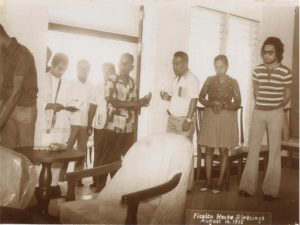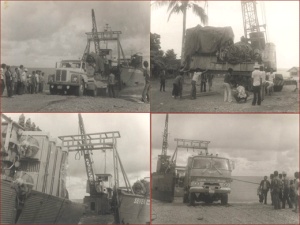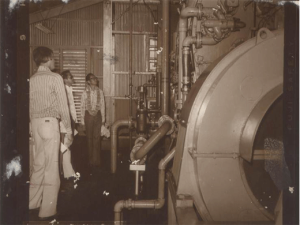 On October 28, 1971, the First Electric Cooperative, Inc. was established under PD 6 as amended. It was spearheaded by a team of Provincial Officers coming from the province’s different sectors.
On October 28, 1971, the First Electric Cooperative, Inc. was established under PD 6 as amended. It was spearheaded by a team of Provincial Officers coming from the province’s different sectors.
Being one of the first electric cooperatives to be organized in the country, FICELCO became a recipient of the initial shipment of power generating equipment from the USAID in 1972.On April 1, 1972, the Magsaysay Electric Distribution System owned by the Provincial Government was operating on the Municipalities of Virac and Bato. FICELCO entered into a lease agreement with the Province of Catanduanes to operate the electric system while expanding its service area. The experience during the transition period from leasing to final ownership of the system proved valuable to the Management of the Co-op, GM Amado M. Tacorda was then able to re-orient the consumers of their new responsibilities.
For a few months, FICELCO was able to sustain the cost of operations then it was jolted by the fuel price hike in October, 1973. Expansion plans had to be reined back, priorities restructured and the use of alternative energy sources started to be conceptualized.
In May, 1975, the construction of its power plant and headquarter was completed. FICELCO became ready to serve the power demands of its growing membership. New line extensions in the Municipalities of Virac, Bato, San Andres and San Miguel were inaugurated in August, 1976. Gigmoto was inaugurated in May, 1978 and an interim power plant was installed in Viga in June, 1979.
 Then, the First Lady Imelda Marcos the Chairperson of the National Electrification Administration signed a loan agreement for the construction and development of a hydro electric power plant in Balongbong, Bato; another hydroplant in Hitoma, Caramoran and the Dendro Therma Project in Buyo, Virac.
Then, the First Lady Imelda Marcos the Chairperson of the National Electrification Administration signed a loan agreement for the construction and development of a hydro electric power plant in Balongbong, Bato; another hydroplant in Hitoma, Caramoran and the Dendro Therma Project in Buyo, Virac.
Faced with the crunching effects of the escalating fuel prices and ever increasing maintenance costs of its power generating equipment, the cooperative embarked on an ambitious and rapid development of the energy potentials of the island. The construction of the 1.8 MW Balongbong Mini-Hydro Pant was started in June, 1982 meanwhile, the development of the 600-hectare ipil-ipil plantation was started to supply the fuel wood requirements of the proposed Buyo Dendro Thermal Plant.
In June, 1983, the operational activities were greatly restricted due to acute shortage of power plant generating capacity and the high cost of selling power.While the peak demand went up to 1,00 KW, the generating capacity declined to 800 KW.On June 27, 1983, the Balongbong Mini-Hydro Plant was inaugurated despite pending 100 percent accomplishment of the balance of work.
 As power utilities in the Luzon grid strain under heavier rate burden imposed by NAPOCOR. FICELCO entered an era of de-escalating energy cost made possible by a renewed reliance on indigenous source of power.
As power utilities in the Luzon grid strain under heavier rate burden imposed by NAPOCOR. FICELCO entered an era of de-escalating energy cost made possible by a renewed reliance on indigenous source of power.
Typhoon “Warling” in 1983 destroyed the headrace, penstock and substation of the yet to be completed Balongbong Project. It literally brought down the Coop. Consumer confidence waned along with the Co-op credibility and goodwill when electric service schedules dwindled from a 12-hour to 4-hour periods on the driest months. As revenues became scarcer, collections suffered as cash for purchases, payment for salaries and salary differential became largely inadequate.
The experience during the transition period from leasing to final ownership of the system proved valuable to the Management of the Co-op, GM Amado M. Tacorda was then able to re-orient the consumers of their new responsibilities. For a few months, FICELCO was able to sustain the cost of operations then it was jolted by the fuel price hike in October, 1973. Expansion plans had to be reined back, priorities restructured and the use of alternative energy sources started to be conceptualized. After a long search for solutions, the management finally secured a negotiated agreement with a consortium of local contractors to undertake immediate rehabilitation works on the Balongbong Project. Rehabilitation activities were completed in November 1984.
The steady rebound of electric revenues helped prop-up Co-op operation. In 1986, the Provincial Government decided to play a lead role in the extension of power lines to Pandan and Caramoran to eventually link-up with the Hydro power source from Balongbong.
The year 1987, ushered critical and important changes in the operation of the Co-op. NEA, acting in accordance with the provisions of P.D. 1645, decided to take direct hand in the operations of the Co-op by sending two-man Management Assistance Team.
Faced with the formidable problems and operating in harsh socio-economic and political environment, the Co-op was able to overcome hurdles to set the stage from recovery and sustained growth in the years ahead following excellence schemes. The upswing of its physical performance enabled the Co-op to renew its amortization dues andsettle other financial obligations. The influence of exerted was likewise positively translated in all other areas of concern as system losses dropped and house connections substantially increased.
The Presidential pronouncement on May 1, 1988, transferring all power generating chores of every self-generating electric cooperative to the National Power Corporation not only relieved FICELCO of the burden of costly power generation and maintenance but also provided the logical direction to the eventual operational take-off. The Co-op developed a tripartite with NAPOCOR and NEA for the smooth transition and productive co-existence.
 FICELCO finally achieved a breakthrough in collection efficiency when it surpassed the 90 percent psychological barrier to post an average of 96 percent in the last quarter of 1988, and 97 percent in the first quarter of 1989.
FICELCO finally achieved a breakthrough in collection efficiency when it surpassed the 90 percent psychological barrier to post an average of 96 percent in the last quarter of 1988, and 97 percent in the first quarter of 1989.
Thus, for the first time, FICECO joined the elite rank of electric cooperatives which have attained more than 95 percent collection efficiency. NEA’s recent re-categorization of electric cooperatives nationwide proved FICELCO’s exemplary performance and laudable sense of achievement thereby elevating it among ranks of viable coops in the country.
The total electrification agenda for Catanduanes proposed in 1989 by the Presidential pronouncement highlighted the priority programs during the year through 1990. Fund sourcing consequently delayed implementation as the project turned form an issue of technology and financing capability to one of moral and social obligation and commitment even as the Danish government thru its international agency for development (DANIDA) favourably project on an outright grant.
Expansion and maintenance programs were largely hampered by the inadequacy of pole-line materials and KWH meters. However, the Co-ops status on electrification continued to grow through self-help efforts with intensification of putting up Barangay Power Associations and holding Barangay Electricians Courses.
Despite the escalation of fuel prices, which resulted in mild rate increase for the first time, the 1M-Peso monthly revenue mark has been achieved.
The consequent depreciation of Philippine Peso vis-à-vis US dollar and other currencies made FICELCO operations most costly considering that the Co-op uses mostly imported materials for its line maintenance, construction and operation. These factors were greatly instrumental in the Co-op’s decision to increase its rates.
In 1998, typhoon “Loleng” brought devastating effects to the Co-op’s distribution system. The FICELCO restoration workforce was assisted by CEBECO I, II and III. “Task Force Catanduanes” was initiated by the General Manager of this Co-ops Fr. Francisco G. Silva and their Board of Directors.
The Co-op’s clientele through the years as the Co-op continued to face challenges. More so, the Co-op employees continued to upgrade their knowledge and skills by attending selected seminars and trainings. The Co-op also continued implementation of its radio program, publication of information materials and pre-membership seminars.
With the passage of the Electric Power Industry Reform Act, electric cooperatives faced new challenges and opportunities.
 In 2002, two rented gensets from Monark were commissioned and the remaining two rented genset which were stationed at the mooring site of Power Barge 110 were likewise commissioned using the sub-station transformer and control panels. The acute power supply crisis was temporarily resolved. Hence, the Management and the provincial government petitioned to Pres. Gloria Macapagal-Arroyo for the retention of the rented gensets until such time that NAPOCOR’s generating capability should have been augment.
In 2002, two rented gensets from Monark were commissioned and the remaining two rented genset which were stationed at the mooring site of Power Barge 110 were likewise commissioned using the sub-station transformer and control panels. The acute power supply crisis was temporarily resolved. Hence, the Management and the provincial government petitioned to Pres. Gloria Macapagal-Arroyo for the retention of the rented gensets until such time that NAPOCOR’s generating capability should have been augment.
FICELCO continues to grow as information programs were conducted in different high schools in the province. The Co-op continued its energization of eight barangays in the island.Then in 2004, the Unbundling of Rates was implemented per compliance to ERC Memorandum. The Energy Regulatory Commission promulgated the Magna Carta for Residential Consumers to which new applicants gather every Friday for the orientation seminar at the FICELCO compound as a requirement for new connections.
Typhoon “Reming” in 2006 caused tragic experience to the entire province. Restoration became the priority of the Co-op. with the combined enthusiasm and efforts of the Management, employees and the member-consumers; the energy was restored in the province within three months.
The Annual General Membership Meeting continued to be held at the different districts of the province. FICELCO also joins festivities such as the annual Christmas Cheers and sports activities sponsored by the different sectors of the province.
After 36 years of hard-earned endeavour, FICELCO having achieved 100 percent energization now continues its journey to achieve service excellence and be at part with the elite electric cooperatives. Being the sole franchise holder in Caatanduanes in terms of electric distribution it continues to serve 38,000 member-consumers of the 11 municipalities with the mission of taking major role in the socio-economic development of Catanduanes by delivering affordable, dependable, efficient and reliable electric service to its member-consumer.
